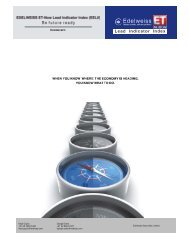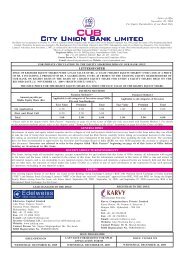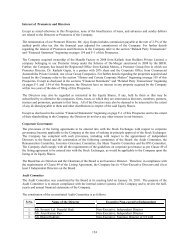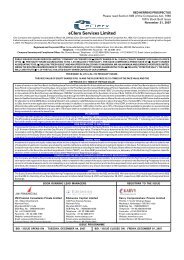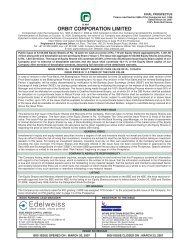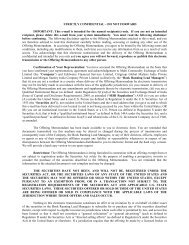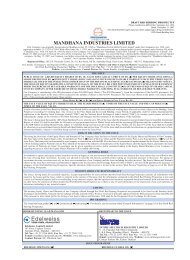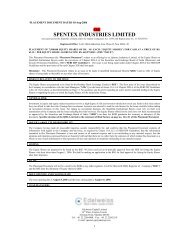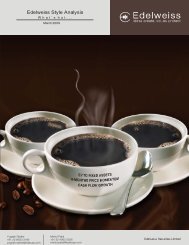Annexure XIV Continued⦠- Edelweiss
Annexure XIV Continued⦠- Edelweiss
Annexure XIV Continued⦠- Edelweiss
You also want an ePaper? Increase the reach of your titles
YUMPU automatically turns print PDFs into web optimized ePapers that Google loves.
Impairment<br />
The carrying amounts of assets are reviewed at each balance sheet date in accordance with Accounting<br />
Standard 28, "Impairment of Assets," to determine whether there is any indication of impairment. If any such<br />
indication exists, the asset's recoverable amount is estimated. An impairment loss is recognized when the<br />
carrying amount of an asset or its cash generating unit exceeds its recoverable amount. Impairment losses are<br />
recognized in the profit and loss account. An impairment loss is reversed if there is a change in the estimates<br />
used to determine the recoverable amount. An impairment loss is reversed only to the extent that the asset's<br />
carrying amount does not exceed the carrying amount that would have been determined net of depreciation or<br />
amortization, if no impairment loss had been recognized.<br />
Provisions and contingencies<br />
We recognize a provision when there is a present obligation as a result of a past event, and it is more likely<br />
than not that there will be an outflow of resources embodying economic benefits to settle such obligation and<br />
the amount of such obligation can be reliably estimated. Provisions are not discounted to their present value<br />
and are determined based on the management's best estimate of the amount of obligation required at the year<br />
end. These are reviewed at each balance sheet date and adjusted to reflect current management estimates.<br />
Contingent liabilities are disclosed in respect of possible obligations that have arisen from past events and the<br />
existence of which will be confirmed only by the occurrence or non occurrence of future events not wholly<br />
within our control. Contingent liabilities are also disclosed for present obligations in respect of which it is not<br />
probable that there will be an outflow of resources or a reliable estimate of the amount of obligation cannot be<br />
made.<br />
When there is a possible obligation or a present obligation where the likelihood of an outflow of resources is<br />
remote, no disclosure or provision is made.<br />
Results of operations<br />
Explanation of key income statement items<br />
Revenue<br />
Our total income currently comprises income from coal beneficiation and allied receipts (such as logistical<br />
services); income from sale of coal; income from sale of power; income from sale of sponge iron; sale of<br />
equipment (which is only to our associates); and other income.<br />
In accordance with the Accounting Standard on Segment Reporting, (AS 17), we report the financial<br />
statements of our business in five separate segments. These segments relate to our businesses in (a) coal<br />
operations (which includes revenue from coal beneficiation and allied receipts and from the sale of coal), (b)<br />
wind power, (c) thermal power (which, together with wind power, comprises our revenue from the sale of<br />
power), (d) sponge iron and (e) equipment manufacturing.<br />
Coal operations<br />
Income from coal beneficiation and allied receipts<br />
Income from coal beneficiation and allied receipts primarily refers to income generated from coal beneficiation<br />
and transportation and logistics services.<br />
Sale of coal<br />
The income from sale of coal is primarily from sales of coal rejects produced as a result of the beneficiation of<br />
coal, sales of reprocessed rejects and sales of coal (both processed and unprocessed) purchased through the e-<br />
auction scheme conducted by Coal India Limited and its subsidiaries and sales of a blend of raw coal<br />
purchased from third parties and coal rejects.<br />
Wind and thermal power<br />
Our wind and thermal power projects derive income primarily from the sale of electricity to state-owned<br />
distribution companies.<br />
286




